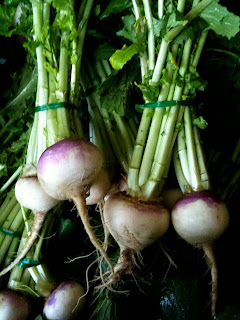 |
| Jed digs local fruit |
 |
| Walker shares loquats and nasturtium blossoms from her garden |
Here's what Farmer John had for us at the Silver Lake pick-up this week:
Garlic
Beets, red and gold
Arugula
Mustard greens
Butter lettuce
Green chard
Russian kale
Collard greens
Mint
Red romaine
Chamomile
Collard greens are often prepared chopped and cooked slowly with a ham hock. This traditional preparation produces tender greens and a smoky pot liquor that's intoxicatingly delicious.
Jed suggested a completely different approach to collard greens - using them as a wrap with a vegan filling of vegetables and grains. What a great idea!
Collard Wraps
For 4 wraps:
5 medium collard leaves
2-3 T finely chopped red onion
1 C sliced mushrooms, shittake are particularly tasty
1/2 C grated carrot
1 C cooked brown rice, or quinoa, or barley
1 T canola oil
salt and pepper to taste
1. Start by selecting 4 medium collard leaves that are intact (no holes). Bring a 3-4 qt pot of water to a boil and blanch the 4 leaves, one at a time, by holding the stem and dipping the leaf in the boiling water for 5 seconds. Set aside and repeat with the other leaves.
2. Remove the stems from the blanched greens and slice them thinly. Set aside.
3. Take the remaining unblanched collard leaf: Chop the leaf in coarse strips and chop the stem thinly, same as the others.
4. In a 10-inch skillet, heat the canola oil over medium heat. Add the onions and saute until translucent, about 1 minute.
5. Add the thinly sliced collard stems and the mushrooms. Cover and turn down the heat a little. Cook until the mushrooms have exuded their moisture.
6. Add the chopped collard leaf and cover again until the it has wilted and softened somewhat.
7. Uncover the pan, turn the heat back up a little. When most of the water has cooked off, add the grated carrots and the cooked brown rice (or quinoa or barley). Cook until the carrots are slightly softened and the grain is heated through, stirring to combine. Season with salt and pepper to taste
8. Remove the filling from the heat and assemble the wraps: Take one-fourth of the filling and place it in the center of one blanched leaf. Fold the top of the leaf over the filling, then fold each side in toward the center, leaving the stem end open [or use the whatever wrapping technique you prefer]. Repeat with remaining blanched leaves and filling.
Enjoy!
Shelley



























